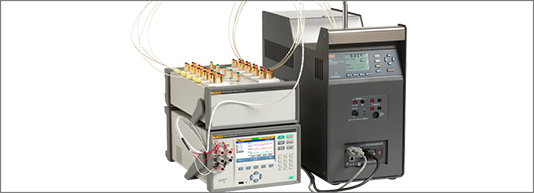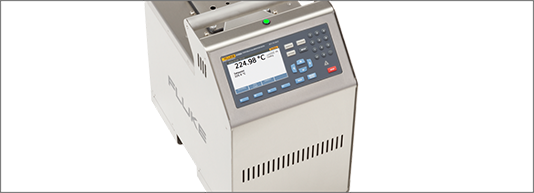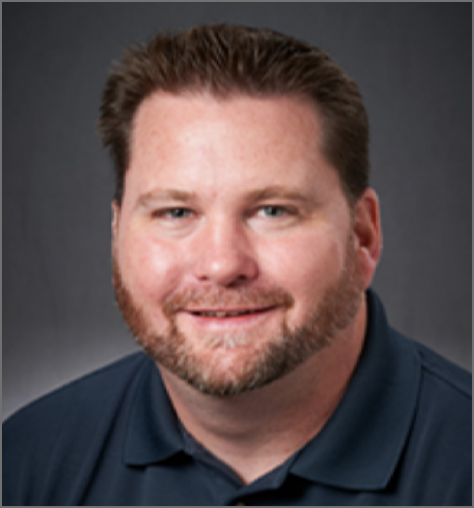Solutions for Pharmaceutical, Biotech and Medical Device manufacturing and development requires precise, reliable tools that keep critical processes up and running and also comply with stringent regulations. Calibration, verification and other tests are required for compliance with regulations like the Food and Drug Administration (FDA) Current Good Manufacturing Processes (cGMP). Failure to comply with these regulations can result in a FDA Form 483 warning letter, consent decree or worse.
Fluke Calibration offers solutions for temperature, humidity and pressure calibration and verification, as required by the FDA and cGMP. Click on the navigation to explore solutions that can increase the throughput, accuracy and reliability of your calibrations and measurements
Sensors such as RTD’s, PRT’s, thermocouples, tri-clamp sanitary clamps, dial gauges, thermistors and others sensors that monitor and control temperature’s must be calibrated and verified. How often depends on how critical the sensor is to the process - most sensors are calibrated every 3 to 6 months but we have seen them calibrated as often as once a week or each production batch in the pharmaceutical industry. One customer, a large pharmaceutical company, calibrates their RTD’s every week since they are critical to product quality and assurance!
Increase the throughput of your lab and field calibrations by using the Automated Test feature of the 1586A Super-DAQ. Fully automate the calibration process with a single temperature source that covers the calibration range. Users can start a test and walk away to perform other tasks while the 1586A automatically records data once the source has stabilized—no need to check and re-check temperature source stability, for up to 40 Units Under Test (UUTs) in a single calibration batch.
The 1586A can be used in the lab where temperature sensors from manufacturing such as sterilization, chemical processing, fermentation, testing and packaging can be removed. Place the 1586A on a cart to calibrate sensors on incubators, bioreactors, or stability chambers in the field.
Travis Porter Fluke Calibration Temperature Expert Travis Porter has spent 20 years as a temperature calibration expert in roles with Fluke Calibration and the former Hart Scientific. These roles include technical support, manufacturing and sales. He currently works as a Temperature Expert on our Inside Sales Team, helping customers figure out the best solution to fit their application.![]() Read how to Automate Temperature Sensor Calibration with the 1586A Super-DAQ
Read how to Automate Temperature Sensor Calibration with the 1586A Super-DAQ![]() Watch the on-demand webinar: Automating Temperature Sensor Calibration
Watch the on-demand webinar: Automating Temperature Sensor CalibrationBest solutions for common temperature sensors:
Thermocouples, Resistance Temperature Detectors (RTD’s), Thermometers in the lab

Thermowells on bioreactors, tri-clamp sanitary clamps on mixing vessels, steam-in-place SPI, clean-in-place CIP, dial gauges in the field


When demonstrating to regulatory agencies that appropriate levels of temperature accuracy and uniformity are being maintained in freezers, refrigerators, incubators, autoclaves and ovens, chamber mapping needs to be completed, sometimes as often as seasonally. Power failure, open door studies and empty/full configurations are also tested. To complete chamber mapping, thermocouples or data loggers are first calibrated, as all testing equipment should be before a critical measurement. Once calibrated, they are positioned at specific locations within the chamber, then the process is run through in its entirety. The data is collected and analyzed to verify temperature uniformity so that product quality isn’t impacted by hot or cold spots.
The Fluke Calibration 1586A Super-DAQ Precision Temperature Scanner can be used for chamber mapping with TQ Software to comply with FDA 21 CFR Part 11. This also allows for easily measuring temperature uniformity of the chamber directly without having to apply thermocouple offsets manually.
If you are calibrating at temperature over 700°C, use the Fluke Calibration 9118A with an isothermal block and a 5650 Type-S reference grade thermocouple.

Travis Porter
Fluke Calibration Temperature Expert
Travis Porter has spent 18 yers as a temperature calibration expert in roles with Fluke Calibration and the former Hart Scientific, including technical support, manufacturing and sales. He currently works as an Fluke Calibration Temperature Expert .
Data loggers are compact and easy-to-use recorders for monitoring humidity levels of equipment and facilities, including incubators, stability chambers, refrigerators, and freezers. These data loggers require periodic calibration. The 5128A RHapid-Cal Humidity Generator is ideal for calibrating humidity data loggers used to monitor pharmaceutical and biotech processes
To calibrate data loggers, place them directly into the Fluke Calibration 5128A test chamber. If the data logger display allows, it can be visually read through the clear door and compared with the 5128A reference value. Otherwise, put the data logger into “logging” mode. Then set and record the actual 5128A temperature and humidity at known points in time. The logged data is then compared against the actual 5128A temperature and humidity settings. Data loggers that are too large to fit on the shelf accessory can be placed in the bottom of the chamber. To accommodate even larger loggers, the chamber mixing insert can be removed, providing ultimate versatility.
![]() Read the Top 7 Fearures of the 5128A RHapid Cal Humidity Generator
Read the Top 7 Fearures of the 5128A RHapid Cal Humidity Generator
![]() Watch a quick introduction video
Watch a quick introduction video

Travis Porter
Fluke Calibration Temperature Expert
Travis Porter has spent 20 years as a temperature calibration expert in roles with Fluke Calibration and the former Hart Scientific. These roles include technical support, manufacturing and sales. He currently works as a Temperature Expert on our Inside Sales Team, helping customers figure out the best solution to fit their application.
Gas Flow meters such as Mass Flow Controllers (MFC) need to be precise, especially in pharmaceutical manufacturing where batch processes use gas and liquid to produce safe, quality product. Flow meters on bio-reactors, fermenters, storage tanks (for tank blanketing), pill coating, ovens, and dryers are critical. These meters measure gas or liquid released into reactors for the manufacturing of cells or medium, they measure gas release into storage tanks to blanket toxic gases to keep workers safe and the measure flow in pill coating to ensure a precise, even layer of thickness is coated to very specific specifications.
For Fluke Calibrations lowest uncertainty available for gas flow meter calibration and controller calibrations, utilize the Molbox1+ Flow Terminal. Ideal for gas flow meter calibration, Mass Flow Controllers (MFCs) and other flow measurement devices.
![]() Read the 4 Steps to more Effective Gas Flow Calibration
Read the 4 Steps to more Effective Gas Flow Calibration
![]() Watch the on-demand webinar: 5 Things to Consider when Calibrating Compressed Gas Flow Meters
Watch the on-demand webinar: 5 Things to Consider when Calibrating Compressed Gas Flow Meters

John Lopez
Fluke Calibration
John Lopez has spent 10 years in software development and applications engineering before joining Fluke in 2016. He currently works as a Pressure Expert on our Inside Sales Team. He says “the combination of technical work and customer interaction” is his favorite part about his job. Give him a call today to talk about your specific pressure or flow application.
Probes, transmitters and other temperature sensors that are permanently mounted in freeze driers (lypohilizer), freezers, fridges, incubators, stability chambers, environmental chambers, ovens, dry heat sterilizers (depyrogentator) and warehouses can provide challenges when calibrating and verifying. Some sensors can be permanently fixed or difficult to remove, making calibrating with a single-point of verification the easiest choice. To ensure quality assurance, single-point verification is most effective when combined with other trends and information related to the process and equipment. To complete a single-point verification, use the Fluke Calibration 1523 or 1524 Reference Thermometer as the readout with a reference RTD or PRT (PRT are recommended) which will allow data logging to capture trends. Usually, the RTD or PRT is placed in thermal equilibrium next to the sensor, without removing it from the process. If applicable, wire the RTD and PRT through the door or gasket. Once it stabilizes, gather the readings to complete a single-point verification. Choosing the correct probe is important in this application, check out the selection guide below or reach out to one of our Fluke Experts for advice on your specific application.
![]() Choose the right industrial temperature readout and probe
Choose the right industrial temperature readout and probe
| Model | Probe Range | Junction Range | Size | Basic Accuracy4 | Depth |
|---|---|---|---|---|---|
| Secondary Reference PRT1 | |||||
| 5615-6 | -200 °C to 300 °C | -50 °C to 200 °C | 152mm x4.76mm (6.0 in x 0.188in) | ±0.013 °C at 0.010 °C | 100 mm (4.0 in) |
| 5615-9 | -200 °C to 420 °C | -50 °C to 200 °C | 229 mm x 4.76 mm (9.0 in x 0.188 in) | ±0.013 °C at 0.010 °C | 100 mm (4.0 in) |
| 5615-12 | -200 °C to 420 °C | -50 °C to 200 °C | 305 mm x 6.35 mm (12.0 in x 0.250 in) | ± 0.013 °C at 0.010 °C | 127 mm (5.0 in) |
| Precision Industrial PRT1 | |||||
| 5627A-6 | -200 °C to 300 °C | -0 °C to 150 °C | 152mm x 4.7mm (6.0 in x 0.187 in) | ± 0.05 °C at 0 °C | 100 mm (4.0 in) |
| 5627A-9 | -200 °C to 300 °C | -0 °C to 150 °C | 229 mm x 4.7 mm (9.0 in x 0.187 in) | ± 0.05 °C at 0 °C | 100 mm (4.0 in) |
| 5627A-12 | -200 °C to 420 °C | -0 °C to 150 °C | 305 mm x 6.35 mm (12.0 in x 0.250 in) | ± 0.05 °C at 0 °C | 127 mm (5.0 in) |
| Secondary Standard PRT1 | |||||
| 5628 | -200 °C to 661 °C | -0 °C to 80 °C | 305 or 381 mm x 6.35 mm (12.0 or 15.0 in x 0.250in) | ± 0.006 °C at 0 °C | 128 mm (5.0 in) |
| Full Immersion PRT2 | |||||
| 5606 | -200 °C to 160 °C | -200 °C to 160 °C | 50 mm x 3.1 mm (2.0 in x 0.125 in) | ± 0.05 °C | 76 mm (3.0 in) |
| Full Immersion PRT2 | |||||
| 5610 | -0 °C to 100 °C | -0 °C to 100 °C | 152 mm or 229 mm x 3.2 mm (6.0 or 9.0 in x 0.125 in) | ± 0.01 °C | 76 mm (3.0 in) |
117025 accredited calibration included. 2No calibration included. Check with your distributor for calibration options. 3NIST traceable calibration included. NVLAP accredited calibration optional 4"Basic Accuracy" includes calibration uncertainty and short-term repeatability. It does not include long-term drift. | |||||

Travis Porter
Fluke Calibration Temperature Expert
Travis Porter has spent 20 years as a temperature calibration expert in roles with Fluke Calibration and the former Hart Scientific. These roles include technical support, manufacturing and sales. He currently works as a Temperature Expert on our Inside Sales Team, helping customers figure out the best solution to fit their application.
Calibrate humidity sensors for clean rooms, production/manufacturing facilities, product warehouses and other places where humidity control is critical to product quality. Humidity sensors used for monitoring/recording data loggers and hand-held devices require periodic calibration. In critical monitoring/recording installations, a single-point check with a hand-held unit only provides a single point at ambient condition, but its value is limited. In most cases, these sensors are hard wired and cannot be taken back to the lab; however, the portability and speed of the 5128A allows users to perform a three-point check on-site next to the sensor with the right equipment.
Insert the transmitter sensor or Unit Under Test UUT into the chamber, select a set point, and the 5128A chamber will quickly reach a stable and uniform temperature and humidity environment. Use at least three to four calibration points distributed across the humidity range.
![]() Read the Top 7 Fearures of the 5128A RHapid Cal Humidity Generator
Read the Top 7 Fearures of the 5128A RHapid Cal Humidity Generator
![]() Watch a quick introduction video
Watch a quick introduction video

Travis Porter
Fluke Calibration Temperature Expert
Travis Porter has spent 20 years as a temperature calibration expert in roles with Fluke Calibration and the former Hart Scientific. These roles include technical support, manufacturing and sales. He currently works as a Temperature Expert on our Inside Sales Team, helping customers figure out the best solution to fit their application.
Pressure gauges must be periodically recalibrated against a precise reference standard for a pharmaceutical manufacturing process to comply with regulatory agencies, avoid warning letters, and, above all else, ensure product quality. There are pressure gauges on many different processes such as sterilization, cell growth in bioreactors, lyophilization and more that require calibration. Many of these gauges are process critical, especially on filters, pumps and steam-in-place SIP, clean-in-place CIP and production areas like gloveboxes and clean rooms. To automate the calibration of these gauges, the Fluke Calibration 6270A is used with COMPASS® software for improved consistency and throughput, run complete pressure calibration sequences on a single or multiple devices under test (DUTs).
The 6270A offers maximum rangeability and flexibility with its modular design that allows for up to five pressure modules to be installed at one given time with uncertainties as low as 0.01%. Over 80 different modules are offered across three accuracy classes to meet any budget and application. This is the ideal solution for calibration labs that perform on-site calibrations, validations, or calibrations of working standards. If you have draft/room pressure sensors, the Fluke Calibration 7250LP is the most precise pressure standard for calibration draft pressure ranges.
![]() Read our Guide to Getting Started in Pressure Calibration, Breaking down the Barriers
Read our Guide to Getting Started in Pressure Calibration, Breaking down the Barriers
![]() Watch the on-demand webinar: Preventing Contamination in Pressure Calibrations
Watch the on-demand webinar: Preventing Contamination in Pressure Calibrations

John Lopez
Fluke Calibration
John Lopez has spent 10 years in software development and applications engineering before joining Fluke in 2016. He currently works as a Pressure Expert on our Inside Sales Team. He says “the combination of technical work and customer interaction” is his favorite part about his job. Give him a call today to talk about your specific pressure or flow application.
a. Heat treatment processes are used to ensure the desired composition and structure of alloys are reached to meet specifications for hardness, strength, flexibility and toughness. Medical devices that undergo such treatment include implants for hip, ankle, knee, shoulder and other joints as well as heart valves and dental instruments. Fluke Calibration’s 6050H Extremely High Temperature Calibration Salt Bath is ideal for a number of these processes, especially quenching, because of its wide temperature range from 180°C to 550°C and ability to maintain excellent temperature stability (±0.002 °C) and uniformity (±0.005 °C).

Travis Porter
Fluke Calibration Temperature Expert
Travis Porter has spent 20 years as a temperature calibration expert in roles with Fluke Calibration and the former Hart Scientific. These roles include technical support, manufacturing and sales. He currently works as a Temperature Expert on our Inside Sales Team, helping customers figure out the best solution to fit their application.